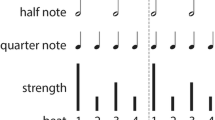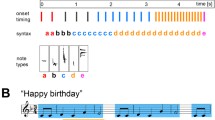Abstract
The influence of tonal modulation in pieces of music on the EEG parameters was studied. An EEG was recorded while subjects were listening to two series of fragments with modulations: controlled harmonic progressions and the fragments of classical musical compositions. Each series included modulations to the subdominant, the dominant, and the ascending minor sixth. The highly controlled and artistically impoverished harmonic progressions of the first series contrasted with the real music excerpts in the second series, which differed in tempo, rhythm, tessitura, duration, and style. Listening to harmonic progressions and musical fragments produced event-related synchronization in the α frequency band. Real musical fragments with modulation to the dominant generated lower synchronization in the α band as compared with other modulations. A lower decrease of synchronization in the α frequency band after listening was observed in the case of fragments of classical music compared with harmonic progressions.
Similar content being viewed by others
References
Fedotchev, A.I. and Radchenko, G.S., Music therapy and brain music: the state, problems and prospective studies, Usp. Fiziol. Nauk, 2013, vol. 44, no. 4, p. 35.
The Psychology of Music, Deutsch, D., Ed., San Diego: Elsevier, 2013, 3rd ed.
McAdams, S., Winsberg, S., Donnadieu, S., et al., Perceptual scaling of synthesized musical timbres: common dimensions, specificities, and latent subject classes, Psychol. Res., 1995, vol. 58, p. 177.
Kong, Y.Y., Mullangi, A., Marozeau, J., and Epstein, M., Temporal and spectral cues for musical timbre perception in electric hearing, J. Speech, Lang., Hear. Res., 2011, vol. 54, p. 981.
Bernardi, L., Porta, C., and Sleight, L., Cardiovascular, cerebrovascular, and respiratory changes induced by different types of music in musicians and non-musicians: the importance of silence, Heart, 2006, vol. 92, no. 4, p. 445.
Guhn, M., Hamm, A., and Zentner, M., Physiological and musico-acoustic correlates of the chill response, Music Percept., 2007, vol. 24, no. 5, p. 473.
VanderArk, S.D. and Ely, D., Cortisol, biochemical, and galvanic skin responses to music stimuli of different preference values by college students in biology and music, Percept. Mot. Skills, 1993, vol. 77, no. 1, p. 227.
Gevorkyan, E.S., Minasyan, S.M., Abraamyan, E.T., and Adamyan, Ts.I., The influence of music on the functional state of students, Gig. Sanit., 2013, vol. 3, p. 85.
Dousty, M., Sabalan, D., and Haghjoo, M., The effects of sedative music, arousal music, and silence on electrocardiography signals, J. Electrocardiol., 2011, vol. 44, no. 3, p. 396.
Foster, N.E., Halpern, A.R., and Zatorre, R.J., Common parietal activation in musical mental transformations across pitch and time, NeuroImage, 2013, vol. 75, p. 26.
Sutherland, M., Paus, T., and Zatorre, R.J., Neuroanatomical correlates of musical transposition in adolescents: a longitudinal approach, Front. Syst. Neurosci., 2013, vol. 7, no. 13, p. 1.
Wan, C.Y., Uber, T.R., Hohmann, A., and Schlaug, G., The therapeutic effects of singing in neurological disorders, Music Percept., 2010, vol. 27, no. 4, p. 287.
Fedotchev, A.I., Bondar’, A.T., Bakhchina, A.V., Parin, S.B., Polevaya, S.A., and Radchenko, G.S., Effects of musical acoustic signals controlled by the subject’s EEG oscillators, Neurosci. Behav. Physiol., 2017, vol. 47, no. 1, p. 47.
Konstantinov, K.V., Leonova, M.K., Miroshnikov, D.B., and Klimenko, V.M., Characteristics of the perception of acoustic images of intrinsic electrical activity by the brain, Neurosci. Behav. Physiol., 2016, vol. 46, no. 1, p. 57.
Fedotchev, A.I., Bondar, A.T., Bakhchina, A.V., et al., Transformation of the patient’s EEG of patient’s oscillators into music-like signals in correction of stressinduced functional states, Sovrem. Tekhnol. Med., 2016, vol. 8, no. 1, p. 93.
Dubovskii, I., Evseev, S., Sposobin, I., and Sokolov, V., Uchebnik Garmonii (Manual of Harmony), Moscow: Muzyka, 1965, p. 436.
Sposobin, I., Lektsii po kursu garmonii. V literaturnoi obrabotke Yu. Kholopova (Lectures on Harmonics in the Literature Overview of Yu. Kholopov), Moscow: Muzyka, 1969, p. 240.
Korsakova-Kreyn, M.N. and Dowling, W.J., Emotional processing in music: Study in affective responses to tonal modulation in controlled harmonic progressions and real music, Psychomusicology: Music, Mind, Brain, 2014, vol. 24, no. 1, p. 4.
Radchenko, G.S., Bakhchina, A.V., Parin, S.B., et al., Influence of tonal modulation of musical fragments on characteristics of EEG and heart rate variability, Neirokomp.: Razrab., Primenenie, 2015, no. 11, p. 65.
Welch, P.D., The use of Fast Fourier Transform for the estimation of power spectra: A method based on time averaging over short, modified periodograms, IEEE Trans. Audio Electroacoust., 1967, vol. 15, no. 2, p. 70.
Benjamini, Y. and Yekutieli, D., The control of the false discovery rate in multiple testing under dependency, Ann. Stat., 2001, vol. 29, no. 4, p. 1165.
Bazanova, O.M. and Vernon, D., Interpreting EEG alpha activity, Neurosci. Biobehav. Rev., 2014, vol. 44, p. 94.
Klimesch, W., Sauseng, P., and Hanslmayr, S., EEG alpha oscillations: the inhibition timing hypothesis, Brain Res. Rev., 2007, vol. 53, no. 1, p. 63.
Jansen, B.H., Agarwal, G., Hedge, A., and Boutros, N.N., Phase synchronization of the ongoing EEG and auditory EPgeneration, Clin. Neurophysiol., 2003, vol. 114, p. 79.
Koelsch, S., A neuroscientific perspective on music therapy, Ann. N.Y. Acad. Sci., 2009, vol. 1169, p. 374.
Lin, Y.P., Duann, J.R., Feng, W., et al., Revealing spatio- spectral electroencephalographic dynamics of musical mode and tempo perception by independent component analysis, J. NeuroEng. Rehabil., 2014, vol. 11.
Thompson, W.F. and Cuddy, L.L., Music performance and the perception of key movement, J. Exp. Psychol., 1997, vol. 23, p. 116.
Caplin, W.E., A Theory of Formal Functions for the Instrumental Music of Haydn, Mozart, and Beethoven, Oxford: Oxford Univ. Press, 2000.
Crause, C.M., Cognition- and memory-related ERD/ERS responses in the auditory stimulus modality, Progr. Brain Res., 2006, vol. 159, p. 197.
Sammler, D., Grigutsch, M., Fritz, T., and Koelsch, S., Music and emotion: electrophysiological correlates of the processing of pleasant and unpleasant music, Psychophysiology, 2007, vol. 44, p. 293.
Bekkedal, M.Y.V., Rossi, J.III., and Panksepp, J., Human brain EEG indices of emotions: delineating responses to affective vocalizations by measuring frontal theta event-related synchronization, Neurosci. Biobehav. Rev., 2011, vol. 35, p. 1959.
Author information
Authors and Affiliations
Corresponding author
Additional information
Original Russian Text © G.S. Radchenko, K.N. Gromov, S.B. Parin, M.N. Korsakova-Kreyn, A.T. Bondar, A.I. Fedotchev, 2018, published in Fiziologiya Cheloveka, 2018, Vol. 44, No. 3, pp. 43–52.
Rights and permissions
About this article
Cite this article
Radchenko, G.S., Gromov, K.N., Parin, S.B. et al. Influence of Tonal Modulation in a Melodic Line on the Spectral Parameters of Human EEG. Hum Physiol 44, 272–279 (2018). https://doi.org/10.1134/S0362119718030131
Received:
Published:
Issue Date:
DOI: https://doi.org/10.1134/S0362119718030131




